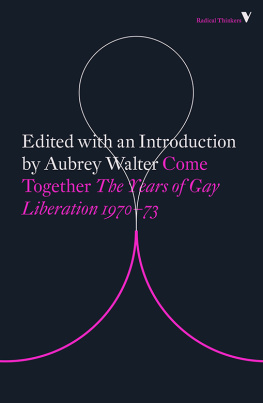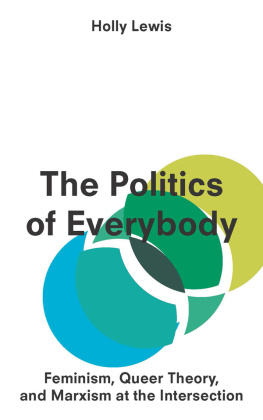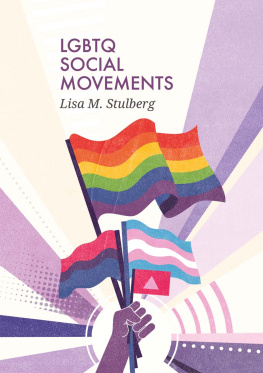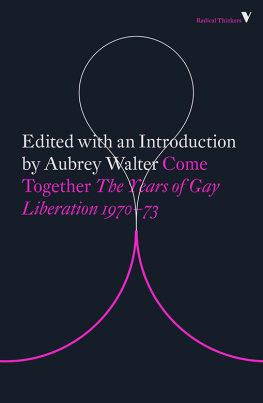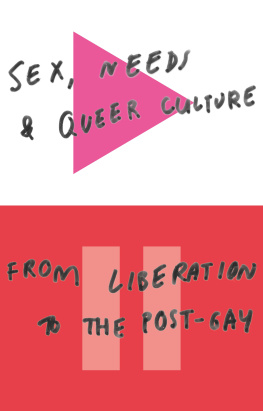Table of Contents
Guide
Pages
One-Dimensional Queer
Roderick A. Ferguson
polity
Copyright Roderick A. Ferguson 2019
The right of Roderick A. Ferguson to be identified as Author of this Work has been asserted in accordance with the UK Copyright, Designs and Patents Act 1988.
First published in 2019 by Polity Press
Polity Press
65 Bridge Street
Cambridge CB2 1UR, UK
Polity Press
101 Station Landing
Suite 300
Medford, MA 02155, USA
All rights reserved. Except for the quotation of short passages for the purpose of criticism and review, no part of this publication may be reproduced, stored in a retrieval system or transmitted, in any form or by any means, electronic, mechanical, photocopying, recording or otherwise, without the prior permission of the publisher.
ISBN-13: 978-1-5095-2355-9
ISBN-13: 978-1-5095-2356-6 (pb)
A catalogue record for this book is available from the British Library.
Library of Congress Cataloging-in-Publication Data
Names: Ferguson, Roderick A., author.
Title: One-dimensional queer / Roderick Ferguson.
Description: Medford, MA : Polity, 2018. | Includes bibliographical references and index.
Identifiers: LCCN 2018019548 (print) | LCCN 2018034841 (ebook) | ISBN 9781509523597 (Epub) | ISBN 9781509523559 (hardback) | ISBN 9781509523566 (paperback)
Subjects: LCSH: Gay rights. | Gay liberation movement. | Social change. | BISAC: SOCIAL SCIENCE / Gender Studies.
Classification: LCC HQ76.5 (ebook) | LCC HQ76.5 .F47 2018 (print) | DDC 323.3/264dc23
LC record available at https://lccn.loc.gov/2018019548
Typeset in 11 on 15pt Adobe Garamond
by Toppan Best-set Premedia Limited
Printed and bound in the United Kingdom by Clays Ltd, Elcograph S.p.A.
The publisher has used its best endeavours to ensure that the URLs for external websites referred to in this book are correct and active at the time of going to press. However, the publisher has no responsibility for the websites and can make no guarantee that a site will remain live or that the content is or will remain appropriate.
Every effort has been made to trace all copyright holders, but if any have been overlooked the publisher will be pleased to include any necessary credits in any subsequent reprint or edition.
For further information on Polity, visit our website: politybooks.com
Introduction
). There were apparently other easy in's for the film as well. It was easy to cast the queens as pre-political sirens who erupted only after Danny prompted them. It was also easy to imagine that the riots began with only heterosexist oppression in mind, this despite the fact that Danny leads the crowd in a chant of Gay Power, a category that could only exist because of the nearness of the black revolution.
In his review, Smith noted that even the trailer for the film worried many with what appeared to be a whitewashed take on a diverse group of people, with some calling for a boycott of the film. Despite the appropriate disapproval that critics heaped onto the film, Emmerich's Stonewall was actually following a convention long in the making. In fact, we might say that the film and its narrative of Stonewall are part of the casualties not only of the mainstreaming of Stonewall but of gay liberation itself.
For the longest time we have believed that queer liberation arose as a single-issue event that was simply about sexuality. Hence, we have told ourselves that queer politics came to issues of race, colonization, incarceration, and capitalism later in its development. This book tells a different story, one in which a multidimensional host of concerns were there from the very beginning only to be excised later on. In fact, since the late sixties from the Stonewall uprisings even the intersectional interests of gay liberation expressed a politics that would try to relate issues of sexuality, race, class, and gender to one another. Hence, part of the book locates gay liberation within a political and intellectual context that was trying to find ways for various struggles to join forces, noting that gay liberation actually emerged out of those efforts of affiliation. One-Dimensional Queer goes on to show that multidimensional and intersectional interests were overtaken by single-issue formulations of queer politics, formulations that would promote liberal capitalist ideologies. Hence, as a multidimensional gay politics transitioned to a single-issue and one-dimensional platform, the meaning of freedom for queer and transgender folks and minorities, in general, shifted radically.
As a critique of the dominant way of narrating queer political histories, the book problematizes the presumption that gay liberation was always and already a single-issue politics. It does so by taking inspiration from the work of groups such as the Gay Liberation Front, Street Transvestite Action Revolutionaries, the Combahee River Collective, Third World Gay Revolution, Gay Latino Alliance, DYKETACTICS! and so on. Challenging the presumption that intersectional activism among queers is a recent phenomenon, the book instead argues that such political models were not recent at all but constitutive of the political aspirations of early gay liberation.
, p. 115).
The one-dimensionality of queerness
, p. xlv).
One-Dimensional Queer is similarly concerned with how incorporating queerness into US state discourse and American capitalism was aided by a single-issue articulation of queer politics. In doing so, the book casts a critical eye on the presumed signs of gay progress the extension of rights to queers and the inclusion of queers within capitalist economic visions. For Marcuse, one-dimensionality represented the containment of social change inasmuch as technical progress was seen as providing people in society with everything that they needed. In the context of the normalization of queerness, one-dimensionality designates the containment of social change inasmuch as the mainstreaming of gay identity and sexuality (i.e. grooming them for the needs of state and capital) are understood to be signs of social progress.
, p. xliv). From Marcuse, we get a sense of one-dimensionality as the conflation of state and capital's needs with personal needs, the understanding of capitalist logics as the epitome of reason, the systematic and deliberate negation of social alternatives, and the acquiescence to the given social and institutional order. This book attempts to show how the mainstreaming of gay liberation attempted to turn queerness into an endorsement of state and capital as the satisfiers of queer needs, as the incarnations of reason, and as the reasons to make peace with the world that capitalism helped to bring about.
The threat of the multidimensional
, p. xlii).
This book attempts to show how intersectional and multidimensional queer struggles (i.e. ones that addressed the overlaps between differences of race, class, gender, and transgender) were key ingredients of that refusal. As the book will show, groups such as Street Transvestite Action Revolutionaries, Third World Gay Revolution, the Combahee River Collective, and DYKETACTICS! offered analyses of interlocking and intersecting oppressions as provocations for improving the human condition and imagining new kinds of peoples and collectivities. Such groups represent the historical evidence of queer and trans capacities to think and live beyond the gender, sexual, racial, and class prescriptions of the world that we have inherited.


